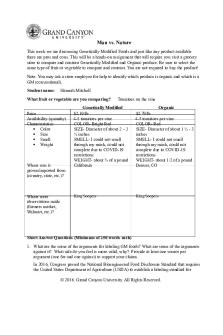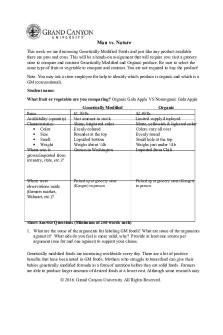Man - dbwqhjdb cnb wefyguawef wfheb PDF

| Title | Man - dbwqhjdb cnb wefyguawef wfheb |
|---|---|
| Author | Ratnesh Jha |
| Course | Engineering Mechanics |
| Institution | Shahjalal University of Science and Technology |
| Pages | 5 |
| File Size | 164.6 KB |
| File Type | |
| Total Downloads | 117 |
| Total Views | 138 |
Summary
dbwqhjdb cnb wefyguawef wfheb...
Description
Man-Machine Systems: Design, Characteristics and Classification Man-Machine Systems: Design, Characteristics and Classification! Human factors are a system concerned with the relationship among human beings, work place or work environment and machines. All man-machine systems are produced with some objective in view. This objective is always well defined and the system is designed so as achieve the objective as successfully as possible. In view of this the operational functions of both the components and constituents i.e. man and machine should be clearly defined. There is one another aspect of man-machine system which, though not strictly a part of it, effects the system performance to a great extent. This is the system environment or what we call as working conditions. The proper integration of man and machine, which is beneficial for human operator and enhances the overall system performance, is a primary aim of the ergonomics discipline. 1. Characteristics of Man-machine System Are as follows: (1) The man-machine system consists of the man, the machine and system environment. (2) It is essentially artificial by nature and is specifically developed to fulfill some purpose or specific aim. (3) It has specific inputs and outputs which are appropriately balanced. (4) It is variable in size and complexity and is dynamic in performance. (5) Subsystems of man machine system interact with and effects the other parts. (6) The man-machine system becomes more efficient when inputs and out puts are adequately balanced. (7) Environmental factors or system environment effects system performance. 2. Classification of Man-Machine Systems: Depending upon size and complexity, man machine systems are of following three types: (1) Manual Systems: They are essentially man directed systems. These are flexible in nature and small in size. Simple tools and equipment are used and the efficiency is dependent upon the human factor. A large variability is possible in a manual system as every worker may select different method to do the same job. (2) Mechanical Systems: They are more complex and inflexible in nature than manual systems. The machine component is power driven and human activity is information processing, decision making and controlling occasionally knows semi automatic systems, they have components which are well integrated. This is the feature which renders these systems rather inflexible. An automobile and a machine tool operated by driver or operator are good examples of his class. (3) Automatic Systems: A complex system in which all operational functions are performed by automatic devices is known as automatic system. Operational functions are sensing information processing decision making and action. It is completely inflexible in nature and cannot be adopted to uses other that the one for which it has be designed. The human element/component performs the jobs of monitoring, programming the function, maintenance and up keep. An automatic telephone exchange, a digital computer and automatic screw cutting, machines are good examples of automatic systems. A perfectly reliable automatic system does not exist at present.
Quality Circles (Q.C): Meaning, Objectives and Benefits Meaning of Quality Circles:
Conceptually Quality Circles can be described as a small group of employees of the same work area, doing similar work that meets voluntarily and regularly to identify, analyse and resolve work related problems. This small group with every member of the circle participating to the full carries on the activities, utilising problem solving techniques to achieve control or improvement in the work area and also help self and mutual development in the process. The concept of the Quality Circle is based on “respect for the human individual” as against the traditional assumption based on suspicion and mistrust between management and its employees. Quality circles built mutual trust and create greater understanding between the management and the workers. Cooperation and not confrontation is the key element in its operation. Quality Circles aims at building people, developing them, arousing genuine interest and dedication to their work to improve quality, productivity, cost reduction etc. Thus we can say that a quality circle is a group of 5 to 8 employees performing similar work, who volunteer themselves to meet regularly, to identify the cause of their on-the-job problems, employ advanced problemsolving techniques to reach solutions and implement them. The concept is based on the premise that the people who do a job everyday know more about it than anyone else and hence their voluntary involvement is the best way to solve their work related problems. The Quality Circle concept provides an opportunity to the circle members to use their wisdom, creativity and experience in bringing about improvements in the work they are engaged in by converting the challenging problems into opportunities and it contributes to the development of the employees and in turn benefits the organisation as well. The concept encourages the sense of belongingness in circle members and they feel that they have an important role to play in the organisation.
Characteristics of Effective Quality Circles:
The atmosphere should be informal, comfortable and relaxed. The members should feel involved and interested. Everyone should participate.
The objectives should be clear to the members. The members should listen to each other. The group should feel comfortable even when there are disagreements. The decisions should generally be taken by a kind of consensus and voting should be minimum. When an action is required to be taken, clear assignments should be made and accepted by all the members. The leader should not dominate the group. The main idea should not be as to who controls but how to get the job done. Until a final solution is found and results are attained feedback is necessary.
Objectives of Quality Circles: Some of the broad objectives of the Quality Circle are:
To improve quality, productivity, safety and cost reduction. To give chance to the employees to use their wisdom and creativity. To encourage team spirit, cohesive culture among different levels and sections of the employees. To promote self and mutual development including leadership quality, To fulfill the self-esteem and motivational needs of employees. To improve the quality of work-life of employees.
Implementation of Quality Circles in an Organisation: For the success of Quality Circle programme, following actions are necessary in the Organisation:
Few managers representing production, quality control, design, process planning form the Quality Circle (Q.C.) steering committee. This acts as a policy making body and will monitor the Q.C. in the Organisation. Top management must attend the orientation courses designed for them. A committed top and middle management is necessary. A facilitator must be appointed, who serves as a link between top management, Q.C., steering committee, middle management circle leaders and circle members. Facilitator will coordinate training courses; get the support from all concerned including top management Q.C., steering committee, circle leader and circle members to help the circle leader in conducting the meetings, and to provide necessary resources.
Organisation and Working of Quality Circles:
Q.C. was conceived in Japan in 1962 as a forum for training its work force for improving the quality of products. Q.C. is a voluntary one. Employees are free to join or not to join. In it, 8 to 10 employees including the Supervisor from same workshop doing similar work join together as a group. The Supervisor can become leader of the group, if the members of Q.C. so desire. It is a part time activity; members of Q.C. are allowed to meet for an hour every week. During the various meetings, these groups progressively identify, select, analyse and solve the problems. Later they offer their proposed solutions to management for consideration, approval and implementation. Additionally a senior officer from same workshop is nominated as facilitator who guides the activities of the group. A Management Committee at senior level is also formed, which overview the progress of Quality Circles. Training of members, leaders and facilitators is very important for the success of programme.
Rules for Quality Circles:
Each member can contribute an idea on his turn in rotation. Each member offers only one idea per turn regardless of how many he or she has in mind. Not everyone has an idea during each rotation, when this occurs just say “Pass”.
No criticism or comments should be passed on the ideas being contributed by the member whatever old it may look to be, welcome their ideas. During brain-storming, no evaluation of suggested idea should occur. This applies equally to leader, phrases such as “We have tried it before”, “Impractical”, “Well” “May be it would work”. “Doubtful”, “Very good” etc. should not be uttered. Members can vote by raising their hands. Only supporting votes are taken. Votes against the ideas are not allowed. The time allotted for brain-storming session should be variable. The length of time that can be spent profitably will vary widely with nature of problem and the group itself. As a general practice, one hour is probably the minimum. While members give their ideas, they are recorded by the Recorder on a large sheet. It is often helpful to set a goal originally, i.e. Let us start for 30 ideas. When all members say “pass” then the first phase of brain-storming session is over. This means all ideas have been exhausted. Now all the ideas recorded on the sheet are displayed. These massive number of ideas are then narrowed down by the process of voting. The voting technique works because the members are experts in their areas. Members vote on each idea. The leader records each vote next to the idea. Members can vote for as many ideas as they feel have value. Only supporting votes are taken. Leader draws a circle around those ideas that receive the most votes. The members thus find that many of the top ideas will be so identified. Now the members can focus on a few important ideas instead of being somewhat confused by a large number of them. These few important ideas are voted on to give ranking to the circle ideas. Leader writes the ranking number beside each idea that has been circled. A member can ask for voting on any idea and argue for or against it. Others can join, if they wish. Only when the discussion has finished then the voting take place.
Idea ranked in the session can then be taken up for analysis or solution later on. Duties of Circle Leader: For the success of Quality Circles, circle leader must have following duties:
He must assume the responsibility of guiding the members. He must make his members sure about what is going on. He must channelise the discussions. Every member is allowed equal opportunity. Specific task be assigned to each member. He must work in coordination with facilitator.
Steps for Setting up Quality Circles: For starting Quality Circles in an organisation, following steps should be taken:
First of all Managers, Supervisors and Foremen must be made to understand the concepts and activities of Q.C. Management’s total support and commitment should be made known to everyone in the organisation. Steering committee is formed with the top management personnel to give direction to Quality Circle activities. A facilitator (or sometimes known as promoter) is selected from the senior management level, who will serve as coordinator and advisor to the circle. Supervisor and foreman are then trained to act as Q.C. leaders.
Members of each circle must be selected from the persons who are doing similar type of work or belong to the same department or section. Membership to the circle is voluntary. First few meetings of the circle are held with a view to train them. To start with, only one to two circles should be formed in an organisation, and then increase the number gradually as more and more experience is gained. Meetings must be held regularly, may be once in a week initially and once in a month on completion of basic training of members. Everyone’s suggestion or problem matching with the circle’s objectives is discussed. Total participation of team members must be encouraged. Recommendations of the circle must be considered and decisions should be taken without delay. Benefits of Quality Circles (Q.C.): Through the forum of Q.C. the chronic problems-of organisations which really create hurdles in work get resolved by the grass root employees of organisation, whose knowledge and experience otherwise is not fully utilized. With such a capable work force, any organisation can easily undertake more difficult and challenging assignments for its growth and profit. As the employees gain experience they take more challenging projects, in due course they undertake projects on cost reduction, material handling, quality improvement, preventing wastage, improving delivery schedule, improving customer service, improving inspection and test methods, preventing accidents improving design and process etc. Cost reduction. Increased productivity. Improved quality. Better communication. Better house-keeping. Increased team work. Smooth working. Better mutual trust. Greater sense of belongingness. Increased safety. Better human relations. Launching of Quality Circle Programme:
The typical steps for launching programme are as under: (i) Orientation Programme for Senior Management Personnel. (ii) Orientation Programme for Managers and Executives. (iii) Orientation Programme for Selected Supervisors. (iv) Orientation Programme for Workers (selected area). (v) Formation of Circles (Minimum 2 and Maximum 4). (vi) Training of Facilitators. (vii) Training of Leaders. (viii) Q.C. meetings for projects....
Similar Free PDFs

3. CNB CCLL Diseño Gráfico
- 240 Pages

CNB Matematicas Ciclo Básico 2019
- 27 Pages

Highway man
- 8 Pages

Age of man - Age of Man
- 3 Pages

BUS MAN Notes
- 43 Pages

questions on lan /man
- 7 Pages

Assignment 2 - Demolition Man
- 9 Pages

Reasonable man test crim
- 3 Pages

Man vs Nature
- 3 Pages

Man VS Nature Worsksheet
- 3 Pages

Fertiliteit van de man
- 12 Pages

Pengertian LAN , MAN ,WAN
- 39 Pages
Popular Institutions
- Tinajero National High School - Annex
- Politeknik Caltex Riau
- Yokohama City University
- SGT University
- University of Al-Qadisiyah
- Divine Word College of Vigan
- Techniek College Rotterdam
- Universidade de Santiago
- Universiti Teknologi MARA Cawangan Johor Kampus Pasir Gudang
- Poltekkes Kemenkes Yogyakarta
- Baguio City National High School
- Colegio san marcos
- preparatoria uno
- Centro de Bachillerato Tecnológico Industrial y de Servicios No. 107
- Dalian Maritime University
- Quang Trung Secondary School
- Colegio Tecnológico en Informática
- Corporación Regional de Educación Superior
- Grupo CEDVA
- Dar Al Uloom University
- Centro de Estudios Preuniversitarios de la Universidad Nacional de Ingeniería
- 上智大学
- Aakash International School, Nuna Majara
- San Felipe Neri Catholic School
- Kang Chiao International School - New Taipei City
- Misamis Occidental National High School
- Institución Educativa Escuela Normal Juan Ladrilleros
- Kolehiyo ng Pantukan
- Batanes State College
- Instituto Continental
- Sekolah Menengah Kejuruan Kesehatan Kaltara (Tarakan)
- Colegio de La Inmaculada Concepcion - Cebu



